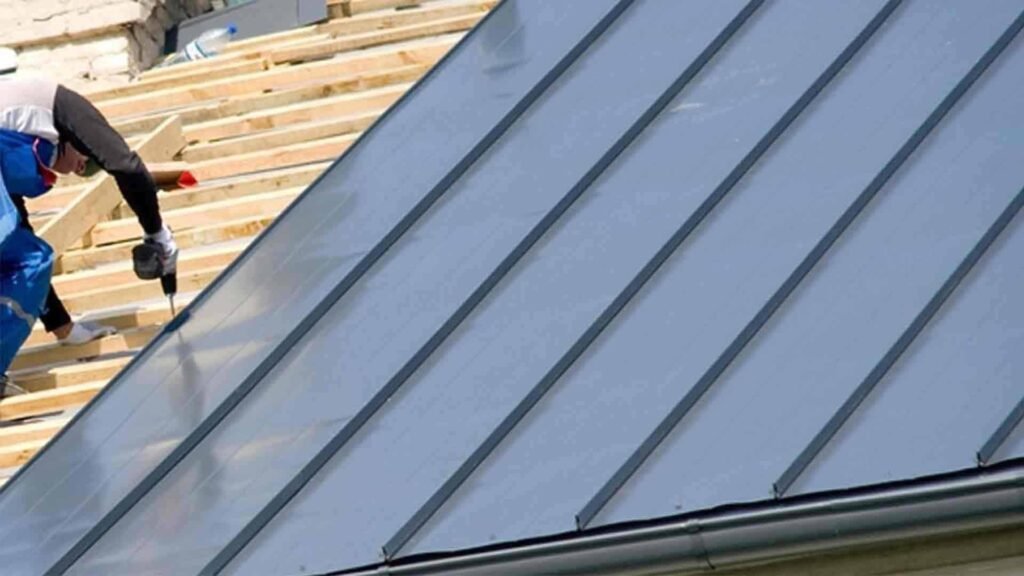Steel roofing lasts 40–70 years, resists fire and pests, and reflects heat to lower energy costs. Installation needs panels, underlayment, closures, sealants, and proper tools. Panels are laid from eave to ridge with overlap, sealed edges, and screw spacing. Mistakes like misalignment or missing closures lead to leaks.
What is steel roofing and why install it?
Steel roofing is a durable, fire-resistant, and energy-efficient roofing material made from galvanized or galvalume-coated steel panels. It is one of the most widely used roofing systems in residential and commercial construction due to its long lifespan and minimal maintenance needs.
Steel panels come in various profiles like corrugated, standing seam, and ribbed formats. These options allow for installation flexibility based on climate, slope, and aesthetics.
Key benefits of steel roofing
- Lasts 40 to 70 years, outpacing asphalt shingles which last 15 to 30 years
- Resists fire, pests, and mildew
- Reflects solar heat, reducing roof temperature by up to 50°F
- Lightweight compared to tile or slate
- Performs well in wind zones up to 140 mph
Because of these advantages, steel roofing is frequently recommended for metal roof installation upgrades and new construction in both urban and rural areas.
What tools and materials are required for steel roofing installation?
Tools
- Cordless drill with torque settings
- Snips or metal shears
- Chalk line, framing square, measuring tape
- Hand seamers
- Roof harness and ladder
- Caulking gun
Materials
- Steel panels, custom-cut to length
- Synthetic underlayment or ice-and-water shield
- Foam closure strips for eaves and ridges
- Butyl tape and sealant
- Self-tapping screws with neoprene washers
- Trim: eave, gable, valley, ridge
All materials must be corrosion-resistant and compatible in finish. For larger structures or existing re-roofs, consider roof installation support for structural planning.
How to prepare the roof for steel panel installation
Clean and inspect the deck
- Remove old roofing if required by code
- Fix any sagging or damaged sheathing
- Clean all debris before laying underlayment
Install underlayment
- Ice-and-water shield for valleys and eaves in cold areas
- Synthetic underlayment for general water protection
- Overlap seams by 4 inches and secure to deck
Snap chalk lines and mark layout
- Snap vertical lines every panel width
- Check square using 3-4-5 method
Plan for ventilation
Install soffit and ridge vent systems, or schedule attic venting repairs to prevent heat/moisture buildup under metal panels.
How to install steel roofing panels step by step
Snap square reference lines
- Use chalk lines to align the first panel
- Check with framing square to avoid shifting pattern
Lay foam closure strips
- Place inside closures at eaves
- Seal with butyl tape above and below
- Blocks insects and moisture from entering panel ribs
Install first panel
- Overhang eave by 1 inch
- Flush the panel to rake edge
- Hold in place before final fastening
Drive screws correctly
- Use 24-inch spacing along purlins or decking
- Drive screws through flat part of panel or per manufacturer guidance
- Compress washer without deforming it
Overlap panel ribs
- Short leg under, long leg over
- Align with anti-siphon groove for drainage control
- Keep all panels facing away from prevailing wind
Remove metal shavings
Leftover filings rust quickly. Clear with brush or air after each cut to protect finish.
How to trim and finish steel roof edges
Install eave trim
- Slide under panel edge
- Nail or screw every 12 inches
- Seal overlaps with butyl
Bend and splice corners
- Use hand seamers to wrap trim around corners
- Overlap by 3+ inches and seal tightly
Install gable/rake trim
- Covers panel ends at slopes
- Use closure strips beneath
- Screw into panels every 12 inches
Apply ridge cap
- Place foam closures under the cap
- Run butyl sealant along peak
- Screw into every rib using 2-inch screws
Poor trim finishing causes leaks and wind uplift. For older homes, consult residential roof repair experts before fitting steel over existing substrates.
What are common steel roof installation mistakes to avoid?
1. Over- or under-tightening screws
- Compress washer just enough
- Avoid warping or leaving gaps
2. Misaligned panels
- A skewed first panel causes long-term alignment issues
- Confirm square with chalk lines and square framing
3. Missing foam closures
- Leads to water and pest entry
- Always install under eaves and ridge cap
4. Incorrect panel laps
- Wrong rib direction defeats water resistance
- Laps should always face away from wind
5. Leaving metal shavings
- Shavings rust fast, creating finish stains
- Brush away all debris after cutting or drilling
6. Trim sequence errors
- Improper overlaps cause leaks
- Follow order: eave > panel > rake > ridge
Repairs caused by installation mistakes are one of the most common requests for roof damage repair services nationwide.
FAQs about installing steel roofing
Can I install a steel roof myself?
Yes, but only for simple structures. Steel roofing on homes requires experience, structural knowledge, and safety training. For steep pitches or multi-surface roofs, hire licensed professionals.
How long does steel roofing last?
Steel roofs last 40 to 70 years, especially when coated with galvalume and installed correctly. Thicker gauge panels and reflective finishes offer added durability.
Is steel roofing noisy in the rain?
No, not when installed over decking with insulation. The myth applies to open-framed barns, not insulated homes.
Does steel roofing save energy?
Yes. According to the U.S. Department of Energy, reflective metal panels can reduce roof surface temperature by up to 50°F, lowering cooling costs.

